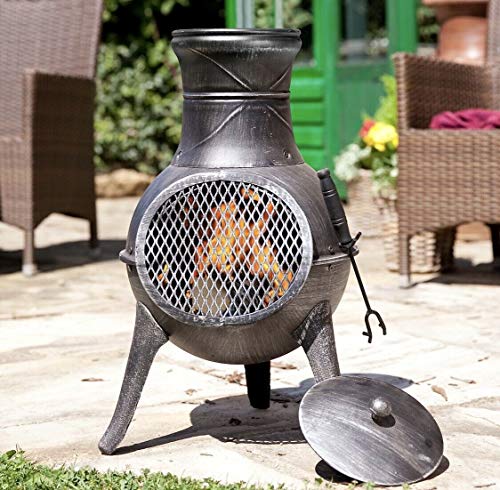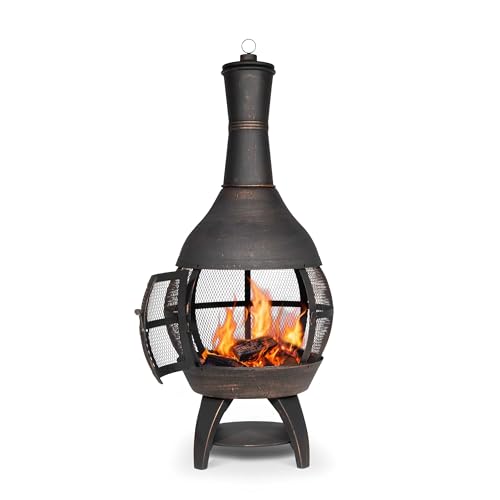The Reason Why Small Chiminea Is More Dangerous Than You Thought
페이지 정보
작성자 Catherine Downe… 댓글 0건 조회 13회 작성일 24-10-23 14:12본문
 A Small Chiminea Provides Warmth Without the Mess
A Small Chiminea Provides Warmth Without the MessThis small chiminea provides all the warmth and convenience of a wood-burning fireplace without the mess. Simply place newspaper that has been lightly scrunched in the sand or log grate, then add logs and kindling before lighting.
This sleek black steel chiminea comes with an oxidized finish that adds a casual look. The 360-degree grate increases the size of your crackling flames, while the tall chimney carries smoke upwards and away from you.
Types
A small chiminea can be used to provide warmth to an outdoor patio or seating area. They also make a great alternative to a grill when cooking outdoors. These units come in many different materials, ranging from terracotta chiminea clay and cast iron to steel. They can be constructed in either a traditional design or a more modern style.
Some models have a chimney that directs smoke away from the seating area. This could be beneficial if you reside in an area that has restrictions on the amount of smoke emitted by outdoor fireplaces or other heat sources. Some models also come with an ash catcher as well as an ash screen within the chimney. Based on the size of your fireplace, you might want to consider a chiminea that is able to support an enormous fire or can hold a large amount of wood.
The type of material your chiminea's made from is important because it impacts its performance and how it looks in your outdoor space. Terra cotta chimineas offer a classic look, but it is susceptible to damage by the elements. A metal chiminea is more durable, however it may require an extra large chiminea layer of protection to avoid rust. A hybrid chiminea consists of a mix of cast iron and stainless steel. It may offer the best qualities of both.
In addition to the kind of material used the size of your chiminea also influences the amount of heat it produces. A larger chiminea will be heavier and cost more, however it also generates more heat than a smaller one.
chimineas uk (Https://sciencewiki.science/wiki/why_we_our_love_for_Chiminea_outdoor_and_you_should_also) typically have a beautiful surface that adds a appeal. Some are embellished with ornaments and carvings while others have simple lines and a plain finish. Some have lids that helps to protect the flames and keep pets and children from being too close. Some models have doors to facilitate the addition of fuel and remove ashes. There are also chimineas that have an integrated grill that allows you to cook food over an open flame.
Safety
There are a few safety precautions to take when buying the smallest, portable chiminea. Chimineas don't pose an immediate threat to pets or children, but they can get very hot. Make sure to take a few steps to ensure that you enjoy your chiminea for years to be.
It is essential to know that a fireplace or wood stove is not a chiminea. They don't have dampers to control the flame and can easily break if they are not handled properly.
Use a fire pits and chimineas-resistant lid on your chiminea. This will prevent rain from getting in and causing damage to the stack. It also helps reduce smoke nuisance. You might also consider purchasing a freestanding, fireproof frame that can stand above the smoke stack and protect it from the elements.
Chimineas can generate lots of sparks when burning and it is recommended to keep them away from flammable materials such as fences, clothes lines and plants. You should also clean the area surrounding your chiminea prior to lighting it. Make sure there is at least six feet of space between it and any combustible object.
Another precaution is to never use gasoline, lighter fluid, or any other accelerant in your chiminea. These liquids pose a fire hazard and can cause an explosion inside the chimney. Also, you should not make use of water to set off the flames in a chiminea because it could cause the clay to crack or break.
You should only make use of wood for your chiminea because it produces less heat and smoke than other fuels. When you light your chiminea, begin with small pieces of kindling and then add larger logs to the flames. If you have difficulty lighting the kindling you can try putting newspaper in a ball before placing it on the grate. This will create a powerful draft that will spark the paper and ignite the kindling.
Do not burn a chiminea in the house because it releases dangerous carbon monoxide gasses, which can be fatal to humans and animals too. Additionally, it's a fire hazard and can cause serious damage to your home.
Maintenance
When used often, a chiminea makes an attractive feature for any outdoor space and provides warmth and ambience. Regular maintenance improves its appearance and reduces accidents and damage and ensures that it will be enjoyed for years to be to. Regular inspections and cleaning of both the interior and exterior are essential to routine maintenance, along with proper storage in off-season weather conditions.
Chimineas should be put in an area that is away from branches and structures with overhangs and away from combustible material such as concrete and pavers. It is also dangerous to place a chiminea under the roof, or on any other structure. Sparks can erupt from the chimney and ignite anything above. The area should be big enough to accommodate a chiminea as well as its flue. There should also be at least a few feet of clearance on all sides.
Chiminies should be washed with a mild detergent and water using soft brushes and a cloth to avoid damaging the clay surface. After washing, the chiminea should be thoroughly rinsed and allowed to dry completely. It is crucial to get rid of any ash that has accumulated in the chiminea bowl and chimney prior to cleaning. When cleaning it is essential to wear gloves to avoid touching the hot soot and ash. During the process, it is essential to check the interior and exterior for any chips or cracks that may require repairs.
Most chiminea retailers sell clay repair kits that can be used to fix cracks. The kits contain all the sealants needed adhesives, sealants, and other components to repair minor cracks. If a crack is not addressed in time, it could become an issue that threatens the safety and integrity of the Chiminea.
In order to keep the chiminea in good shape it must be powered with natural wood products that have been well-seasoned and dry. Burning substances such as painted or treated plastics, wood, or garbage emit toxic fumes that pose a danger to chiminesas. Proper fuel and regular cleaning help keep cracks and damages caused by heat. It is also important to manage the size of fires within the chiminea, and avoid massive, roaring fires that could cause thermal shock and stress to the clay.
Cleaning
A chiminea that is properly maintained will offer many warm and social evenings. Like all outdoor furniture and equipment, a chiminea needs to be maintained regularly to ensure its performance is optimal. It is essential to ensure safety wearing gloves and safety glasses essential to shield your skin from dirt and dust while cleaning. Before cleaning the chiminea it is crucial to ensure that the chiminea is been completely cool. This will not only protect your skin, but also avoid the inhalation of harmful particles that could be hot after previous fires.
Eliminate any large clumps of rust that have built up in the chiminea before you begin the cleaning process. Dispose of them in an appropriate manner. Using a wire brush, gently scrape off loose rust - always making sure to wear your protective gear. A light sanding process is beneficial since it removes any rust particles the wire brush missed, and smooths the surface of your chiminea.
Many home improvement stores offer clay repair kits. It is a good idea to conduct this inspection prior to your first time using the chiminea, as it will help to strengthen the clay and prepare it for regular heating. This is a great way to examine the chiminea's condition for cracks and other damage that might not be apparent when it's not being used.
 It is important to remember that a chiminea must be used outdoors on a non-flammable base such as a concrete slab, sand or hearth pad. This is especially crucial if you have pets or children who could be enticed by the burning sparks, or if it's located close to flammable materials like wooden fences, lighting for your garden, planters and furniture. Also, it's a good idea to place a lid over the top of your chiminea when it's not being used, in order to minimize the chance of flames spreading.
It is important to remember that a chiminea must be used outdoors on a non-flammable base such as a concrete slab, sand or hearth pad. This is especially crucial if you have pets or children who could be enticed by the burning sparks, or if it's located close to flammable materials like wooden fences, lighting for your garden, planters and furniture. Also, it's a good idea to place a lid over the top of your chiminea when it's not being used, in order to minimize the chance of flames spreading.댓글목록
등록된 댓글이 없습니다.